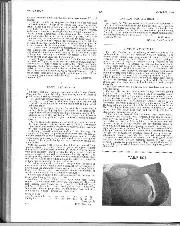
One law for the rich—?
Sir, Mr. Robin N. Thomas refers to our advice to customers to inform our Commissionaire if they have left their car other than at a parking meter and infers there…

Charles Leclerc could only qualify seventh in the Mexican Grand Prix – behind Valtteri Bottas in the usually more sedate Alfa
In theory a turbocharged engine as used in Formula 1 should be immune to the performance loss suffered by a naturally aspirated engine at high altitudes because the turbo can simply turn faster to make the same boost as would be created by lower turbine speeds at sea level. A turbo engine’s combustion chambers should therefore not experience any difference in the oxygen content between low altitude or high.In reality it’s not quite that simple, and the 7200ft (2200m) altitude of Mexico City – by far the highest on the F1 calendar – where the air is around 25% thinner than sea level presented potential problems for the Ferrari power unit in particular.
Ferrari’s turbo arrangement is unique among the four F1 PU manufacturers. Not only is it now the only one to retain a combined turbine and compressor (all the others have the two components split) but it is significantly smaller too. The sizing, together with long inlet tracts, is designed to give super-strong low-speed acceleration. A smaller turbo (only single turbos are permitted by regulation) will spin up quicker and take less electrical energy from the MGU-H to assist it. But to give equivalent maximum boost to a bigger turbo will require it to turn faster.

A catastrophic turbo failure was blamed for Carlos Sainz’s departure from the Austrian Grand Prix in July
This is all good so long as the various shafts and bearings can withstand the higher rotation speeds, which at normal altitudes the Ferrari can. But the requirement for a yet-higher rotation speed to overcome the thin air of Mexico took it into dangerous territory. It wasn’t only the shaft speed which was causing the problem either. The smaller turbo can struggle to meet the boost targets set by the mapping when the resistance at the output end of the compressor is greater than the turbine can overcome, in which case the airflow reverses until conditions stabilise and the compressor is able to work once more. This is known as turbo surge and the oscillations it creates can place unbearable extra stresses on the moving parts.
The warning for this came with Carlos Sainz’s fiery exit from the Austrian Grand Prix (altitude 2100ft; 660m) in July which was later traced to a catastrophic turbo failure. For Mexico, Ferrari was obliged to reduce the turbo’s effectiveness by limiting its rotation speed via the MGU-H (creating a notable high-pitched squealing). The two-fold effect of reducing the airflow and the compressing of the air would mean that the combustion chambers very definitely would have a reduction in the density of the air compared to sea level, therefore reducing the potency of the subsequent bang.
That didn’t fully explain just how far off Ferrari was from Red Bull in qualifying, especially given that the Ferrari-engined Alfa Romeo of Valtteri Bottas – a car which has averaged 1.3sec slower in qualifying than Ferrari over the season – split the two Scuderia cars.
Just as at Spa, the F1-75’s aero efficiency (i.e. the trade-off between drag and downforce) looked mediocre. The reduction in downforce caused by the thinner air seemed to hurt the Ferrari’s balance more than those around it, with both Sainz and Charles Leclerc complaining that it was such a handful through the Esses that it was impossible to put a clean lap together.
“With its reduced power it was losing more time on the straights”
At the same time, with its reduced power, it was losing even more time than usual on the straights to the Red Bull. Ferrari tried trimming the wing levels in FP3 to compensate but both drivers reported it made the car worse to drive for not enough compensating benefit on the straights and so they reverted to full downforce for qualifying and the race.
Sainz and Leclerc finished well adrift of Red Bull and Mercedes in fifth and sixth but a long way clear of the best of the midfield teams, in this case McLaren.

Ferrari was forced to restrict the effectiveness of its turbo in the thinner air of Mexico City
For Interlagos (altitude 2600ft; 800m), Ferrari was able to return its motor to normal power (with some extra precautions to prevent a repeat of Austria) and the car was once more in harmony. Although Q3 was unrepresentative because of the single-lap window of slick running before the rain came, Q2 was held in slick conditions and the Ferraris were second and third, within hundredths of Max Verstappen’s Red Bull.
Although their races were compromised by a PU grid penalty for Sainz and a 10th-place starting position for Leclerc (the team had sent him out on inters in Q3, missing the opportunity for a slick-tyred lap), they recovered well enough in the race to take a respective third and fourth.